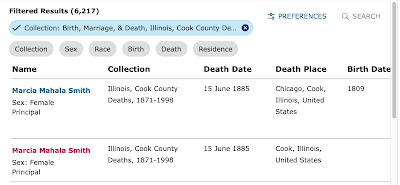But, with a bit of newspaper digging and a good dose of genealogical luck, you might be able to find Cook County property transactions recorded in the digitized volumes that are available in the FamilySearch catalog under "Cook County, Illinois deed records, ca. 1872-1886."
Check Newspapers
For example, if your Chicago ancestor had property sold at public auction you may be able to find a legal notice published in local newspaper, much like this one for Thomas and Mary Ella Parker. Try searching newspapers for names along keywords like "trustee’s sale," "trust deed," "recorded" and "auction." I tried it using my Newspapers Publishers Extra subscription but there may be other ways to access relevant titles.
This legal notice mentions that the deed was "recorded ... in book 55 of Records, page 274." That information is the key to finding the matching record.
"Legal," The Daily Inter-Ocean (Chicago, Illinois), 7 September 1878, p. 11, col. 6; digital image, Newspapers Publishers Extra (https://www.newspapers.com/image/32560115 : accessed 19 November 2019). The Parker notice is the third "Trustee's Sale" listed in the column.
This legal notice mentions that the deed was "recorded ... in book 55 of Records, page 274." That information is the key to finding the matching record.
How To Find the Matching Record
Here’s what to do next:
1. Log into FamilySearch and go to "Cook County, Illinois deed records, ca. 1872-1886." To get there, copy https://www.familysearch.org/search/catalog/447817 and paste it into your browser’s address window or Search > Catalog > Keywords > "cook illinois deed records 1872" or Search > Catalog > Place > United States, Illinois, Cook > Land and Property (4).
1. Log into FamilySearch and go to "Cook County, Illinois deed records, ca. 1872-1886." To get there, copy https://www.familysearch.org/search/catalog/447817 and paste it into your browser’s address window or Search > Catalog > Keywords > "cook illinois deed records 1872" or Search > Catalog > Place > United States, Illinois, Cook > Land and Property (4).
2. Scroll down to find the correct volume (55) and click on the camera icon. These images are available from home.
3. Play the high-low number game to navigate to the correct page (274). In this case, there are two volumes within 1308 images. That means the second volume likely starts about image 650. Page 274 is likely to be in the middle or at the end, so it makes sense to start by viewing a higher-number image, say 1200, which turns out to be p. 268. Browse a few pages forward to page 274.
Cook County, Illinois, deed records, 55: 274 [spread], Parker to Boone, 2 April 1873; accessed in "Cook County, Illinois deed records, ca. 1872-1886," browsable images, FamilySearch (https://www.familysearch.org/ark:/61903/3:1:3Q9M-C37C-398Y-7?i=1211&cat=447817 : accessed 19 November 2019) > Vols. 54-55, digital folder 8576431 > image 1212 and 1213 of 1308; citing Family History Library microfilm 1769597, filmed at the Cook County Warehouse by the Genealogical Society of Utah, 1991.
Things to Note
- From the little bit of detective work I did, it appears that the FamilySearch images are of "record books." If a legal notice mentions a "deed book" it’s unlikely the match can be found in this collection but it never hurts to take a quick look.
- It doesn’t appear that these volumes include indexes at the front or back. It’s likely the Recorder’s Office has indexes, but, if so, they would need to be searched in person.
- It would likely be challenging to locate a deed of interest without the book and page since a deed can be recorded some time after it is executed.
- I have not done a thorough search of newspapers to see if there were any systematic announcements made when deeds were recorded. If you know of any tools that would help researchers access these records, please post a comment or email me privately.



















